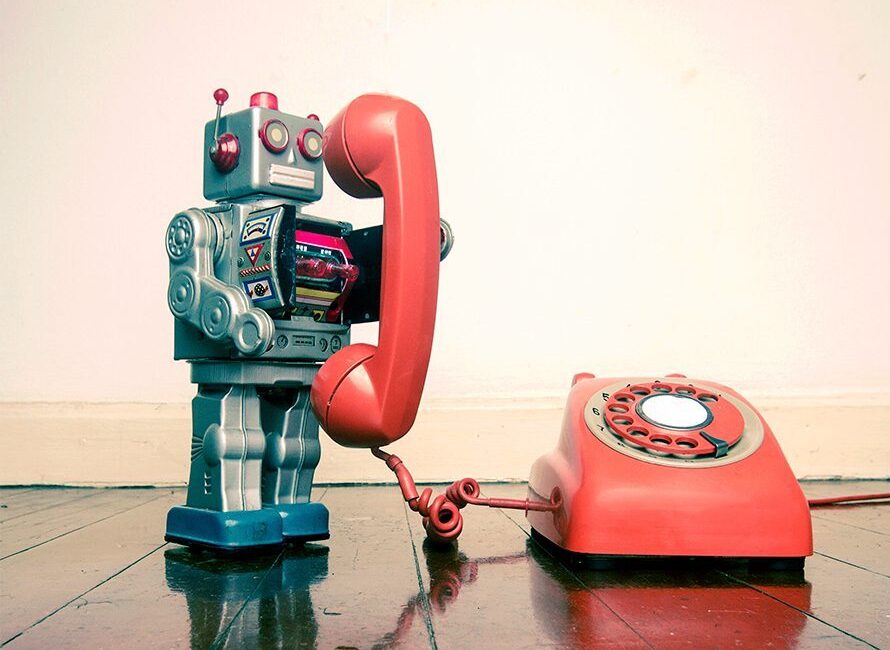Car dealerships understand how important customer relationships are. Without the trust of a potential customer, the sale is lost. But do you have the manpower to handle every customer inquiry that comes your way via email and phone calls?
If your dealership is inundated with customer calls and emails on top of those walking in the door, a chatbot may be the best solution for you.
What’s a Chatbot?
A chatbot is defined as “a computer program that simulates human conversation through voice commands or text chats or both.”
These tools use artificial intelligence (AI) to carry on a conversation through a series of prompts and learned behaviors.
You’ve likely encountered a chatbot pop-up on websites for various companies, from online clothing stores to your town’s municipal services. These bots work to streamline customer interactions with a brand to help them solve a problem or find an answer.
Chatbots can assist your customers with a variety of inquiries, from learning more about your service center to finding the specific car they’ve been searching for. In fact, 56 percent of customers say they would rather send a message on a company website than call customer service.
However, as with most tools, chatbots have their own set of advantages and disadvantages.
6 Benefits of Using Chatbots at Your Dealership
Chatbots can be a useful addition to your sales, marketing, and customer relationship management efforts if used properly. These advantages are sure to make a difference in your day-to-day dealership operations:
1. Continuous Customer Conversation
No matter what time of day a customer visits your website with a question, a chatbot is readily available to help. You won’t need to worry about waking up to a mass amount of emails from late-night website visitors inquiring about vehicles, service appointments, or parts. The chatbot will have already taken care of it and fielded the conversation to the respective department. Whether it’s 7:30 p.m. or 3:00 a.m., a chatbot is ready to connect with your customers.
Additionally, your sales and service teams aren’t always available to answer an email or phone call throughout the workday. According to a survey by Drift, 37 percent of customers expect to get quick answers to questions in an emergency. Alleviate customer anxiety by providing immediate answers to their questions and searches, even if it’s in the middle of the night.
2. Builds Customer Relationships
By continuing customer conversations long after your doors close for the day, you show customers you care about their questions. This is a solid launching point for the rest of the sales process, leaving customers satisfied with their purchase and overall experience.
And your customer now knows, to obtain a rapid response, they can reach out (via chatbot) any time they have a question. This know-how helps them build a relationship with your brand and sales team and, in turn, results in a long-term customer for you.
3. Saves Time and Increases Productivity
Think about how much time your sales and service teams spend answering customer emails, phone calls, and questions throughout the day. Now imagine how much they could accomplish if they had this time back.
Chatbots are capable of speeding up response times and answering up to 80 percent of routine customer questions. When you utilize chatbot technology, your team can focus their energy on productive work around the dealership, rather than leading customers in the right direction.
Consider how much your team could achieve with all that added time.
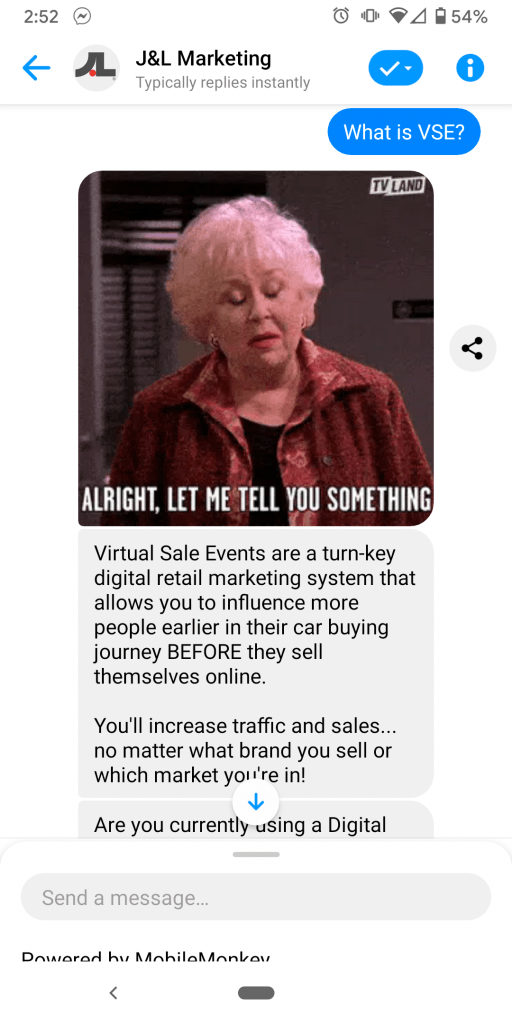
4. Saves Money
Chatbot programs can be pricey, especially the complex platforms. However, when you compare this to the amount of money you’d spend on additional hires, it’s no contest.
And with the amount of time your sales and service teams have regained, they’ll be able to help increase your overall revenue. Reduced costs + more time = more money.
5. Acts as an Additional Content Distribution Channel
Your content marketing plan should include educational articles, videos, and media dedicated to helping customers navigate all things vehicle-related.
Chatbots can be programmed to use your content as answers to specific customer queries. For instance, let’s say you have a blog post all about replacing the headlights on Dodge vehicles. If a customer messages your chatbot stating their Dodge Stratus needs new headlights, your chatbot can also include a link to that respective blog post in their response along with a prompt to schedule an appointment with the service center.
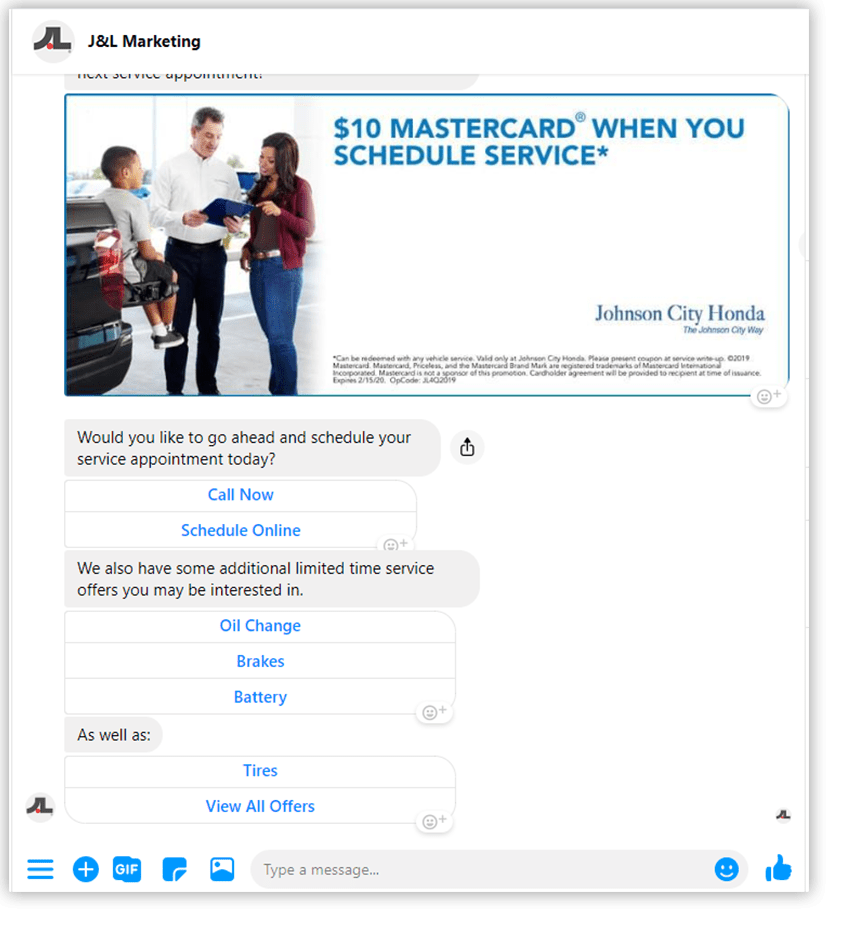
6. Helps Convert Website Visitors Into Leads
If your website sessions aren’t turning into qualified leads or test drives, a chatbot can help convert website visitors into leads by pointing them in the right direction and answering their questions.
4 Disadvantages to Using Chatbots
There is no such thing as perfect technology. Each new platform and tool we implement will have a few negative components. The same concept applies to chatbots.
While chatbots provide a myriad of tangible and intangible benefits for your business, there are a couple of downsides to the tool:
1. Complex Set-Up Required
Wouldn’t it be outstanding if you could download a chatbot program, press “Go,” and have all your customer service problems taken care of?
Instead, chatbots require significant set-up, website integration, programming, and rules to operate properly on both sides of the equation. Aside from installing the chatbot tool onto your website, you’ll also need to:
- Program the chatbot with the proper customer responses
- Integrate your CRM and other marketing tools with the chatbot to help funnel leads to your sales and marketing teams
- Show the chatbot where to field responses for challenging queries
Chatbots that use complex AI to guide new behaviors and responses also require significant set-up time to ensure proper functionality. Also, testing your chatbot to ensure it responds correctly will take up a lot of time, which may affect your manpower and other resources.
2. Unrecognized Queries Can Lead to Customer Dissatisfaction
It’s impossible to know everything a customer might potentially ask your chatbot.
If a chatbot doesn’t know how to respond to a particular query, it will send a pre-written message back to the user. Since that response most likely won’t be exactly what the user is looking for, it will lead to dissatisfaction and potentially negative experiences with your dealership.
To remedy this, program your chatbot to offer various options when it doesn’t know exactly how to respond.
For example, if a customer asks about a specific service that the chatbot doesn’t recognize, have the bot offer to connect the user with other departments at your dealership.
In addition, your chatbot’s tone of voice should be aligned with your brand. Make sure the responses are welcoming and human rather than robotic.
3. Chatbots Aren’t Perfect
Chatbots are only as good as their programming. With this in mind, human error can lead to chatbot mistakes.
Before launching your chatbot to the world, triple-check that all aspects of the programming, language, behaviors, responses, and integrations are seamlessly intertwined for proper functionality.
Although chatbots significantly reduce the amount of customer service mistakes made, they aren’t perfect.
4. Cannot Make Decisions
One of the biggest disadvantages of chatbots is their inability to make decisions. They can follow a series of pathways based on customer responses, which ultimately will lead to a final answer. But they cannot make concrete decisions like a sales or service professional would be able to.
To remedy this, use chatbots as the bridge between your customer, your website, and your dealership. Chatbots are excellent at getting customers to inquire about your company and services. From there, use the information generated by the conversation to get the customer in the door.
Although they may be unable to make decisions, chatbots can help you and your customers get to one.
5 Basic Ways to Use Chatbots at Your Dealership
If you’re thinking about implementing chatbots to help your dealership with customer service, start with basic functions:
Answering Questions About Your Dealership
To become familiar with your dealership, users may ask questions about your facility, including:
- What are your hours of operation?
- Where are you located?
- Do you have a service facility?
- Who do I contact about buying a car?
Brainstorm a comprehensive list of basic questions your customers may have. Then formulate the answers and input them into the chatbot program.
2. Discussing Inventory
One of the most important functions of a chatbot is to help customers find the car they’re looking for. With this in mind, your chatbot must be integrated properly with your inventory system.
When someone asks what Jeep Wranglers you have in stock, your chatbot should be able to pull up a list of available new and used vehicles for the customer.
3. Getting in contact with a Sales Representative
Make sure your chatbot is capable of connecting interested buyers with sales representatives.
Program your chatbot to offer contact information or to notify a sales representative at a specific point in the conversation. Just like in real life, this doesn’t need to be a pushy message. Write the chatbot’s message in a helpful manner and tone so customers feel comfortable moving on to the next stage of the buying process.
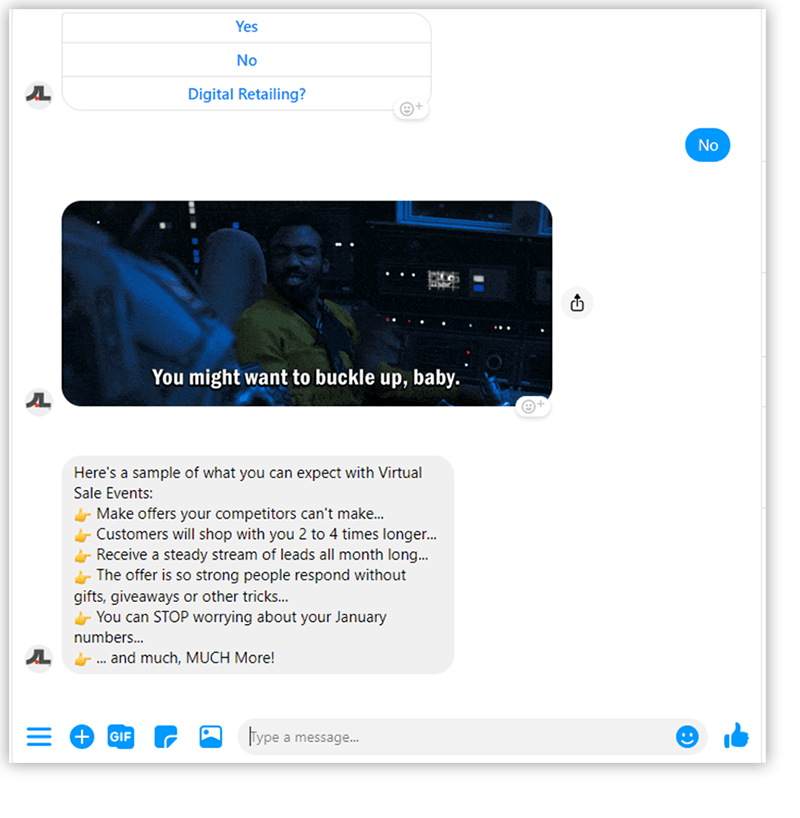
4. Scheduling Service Appointments
Among the simplest and most useful functions of a chatbot is to help customers schedule appointments with your Service Center.
To start, connect the chatbot to your company’s service calendar. From there, provide customers with the option to schedule an appointment. The chatbot will then present the reader with upcoming availability and walk them through the scheduling process.
This quick scheduling trick will free up time for your customer service team to speak with customers in-store and work on any other projects at the dealership.
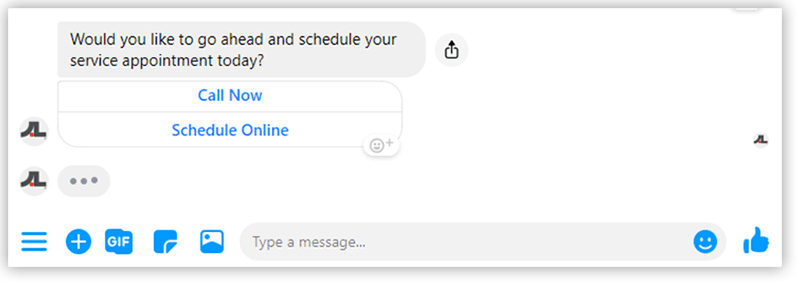
5. Schedule Test Drives
Of course, you want your chatbot to help you get interested buyers into a car for a test drive. Similar to how you set up your Service Center appointment schedule, do the same for test drives.
Allow customers to pick the car they’d like to test drive along with the date and time that works best for them, all via chatbot.
Are Chatbots Right for Your Dealership?
Could your dealership use more time, increased productivity, and improved customer satisfaction? Consider adding chatbots to your website to accomplish all three of these goals.
Contact the J&L Marketing team to start using chatbots as part of your digital marketing strategy to increase profits at your dealership.
